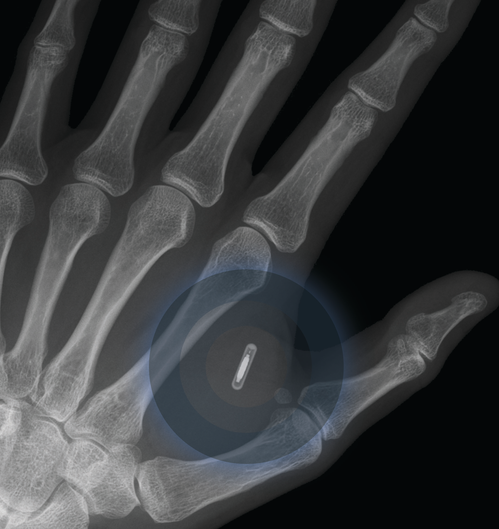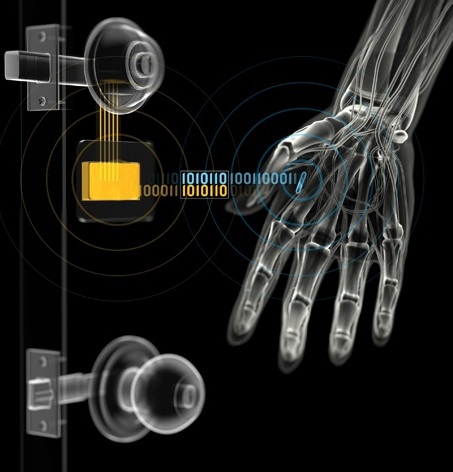RFID & NFC Implants

RFID (Radio-Frequency Identification) is wireless identification of objects using radio waves. RFID chips that are currently implantable are made up of a non-powered transponder and an antenna that uses power from an RFID reader to operate. This type of RFID that relies on a reader for power is referred as passive, and has a very short range of between near-contact to a few millimeters. Active RFID tags on the other hand, which have their own power, can have a range of up to 100 meters, but all current active RFID tags are too large, expensive, their higher frequencies don’t do well with liquids and metal, and their batteries eventually need replacing – and as such they are extremely impracticable to implant.
How It Works:
When a reader is near a passive RFID transponder, it creates a magnetic field that induces a current in the transponder, powering it and transmitting data from the transponder wirelessly to the reader.
NFC
NFC (Near-field Communication) is a type of RFID with a slightly higher frequency (13.56MHz) than a regular passive RFID tag. It has specific standards and protocols set up and owned by the NFC Forum that allow for it to function both as a tag and a reader – a feature most used for peer-to-peer communication for secure data exchange between devices like NFC-capable smartphones. In this regard, NFC is more IoT-adaptable than regular passive RFID, more so as NFC-capable devices will use other associated tech like bluetooth and WiFi to facilitate two-way information sharing.

What You Can Use Your Implant For?
So far RFID technology allows you to use your implant first and foremost as an identification tag. This identification-function is used by biohackers for Access Control to open doors, as car keys, and other authentication processes. The data storage and information-sharing capabilities have been used for contactless payment, for public transport, as passwords and PIN numbers, for storing cryptocurrency, and even for biometrics by those in the Quantified-Self movement.
Improvements on RFID technology will lead to a more integrated fusion between Man and the Internet-of-Things, and as a staple of many DIY-cybernetics biohackers, most of these improvements are likely to come from DIY-hacks. So why not go ahead and implant a chip!
Chip Implantation
There are biohacker startups that sell entire injection kits that come with RFID implants pre-loaded in a piercing needle – ready for injection, making the procedure a simple process of injection and cleaning, without even having to use the services of a professional piercer – although using a professional piercer is highly recommended. If you don’t have such a kit, or you can’t get your chip professionally implanted, then you will need the following to do the procedure yourself:
RFID or NFC tag,
Lidocaine, ice, or anything you can use to numb the pain because it hurts a bit.
Your injection site should be the webbing between the index finger and the thumb. After preparing this area for injection with proper sterilization and sanitation procedures;
Use lidocaine to numb the injection site.
Use forceps to pinch and hold the skin on the site of injection so that it looks like a tent. It is highly recommended that you have someone do this for you and hold the forceps for the entire procedure because you only have two hands.
At a 45° angle, use the piercer’s needle to carefully make a hole of about 4cm into the skin pinched by the forceps.
Remove the piercer’s needle so that you have a hole that resembles a “pocket” because the forceps are still holding part of the skin.
Gently push the RFID or NFC tag all the way into the hole.
Remove the forceps.
Cover the wound until bleeding stops. Properly take care of the site of injection until the wound heals which doesn’t take more than a week.
Security
Although it is difficult to steal information from an RFID chip, particularly one that is sub-dermally implanted, some people still have concerns that criminals at very close proximity can easily use scanners or NFC-capable cellphones to wirelessly scan the data from chips. For this reason, some have opted to use RFID-blocking wallets and RFID-blocking sleeves. The wallets are obviously applicable to credit cards and other non-implanted RFIDs, and so are the sleeves, but you can technically wear the sleeves over the hand, or have them under a glove if you still have concerns about data-theft and want to take extra precaution. Extra precaution that you really don’t need, but understandable if you think you do.